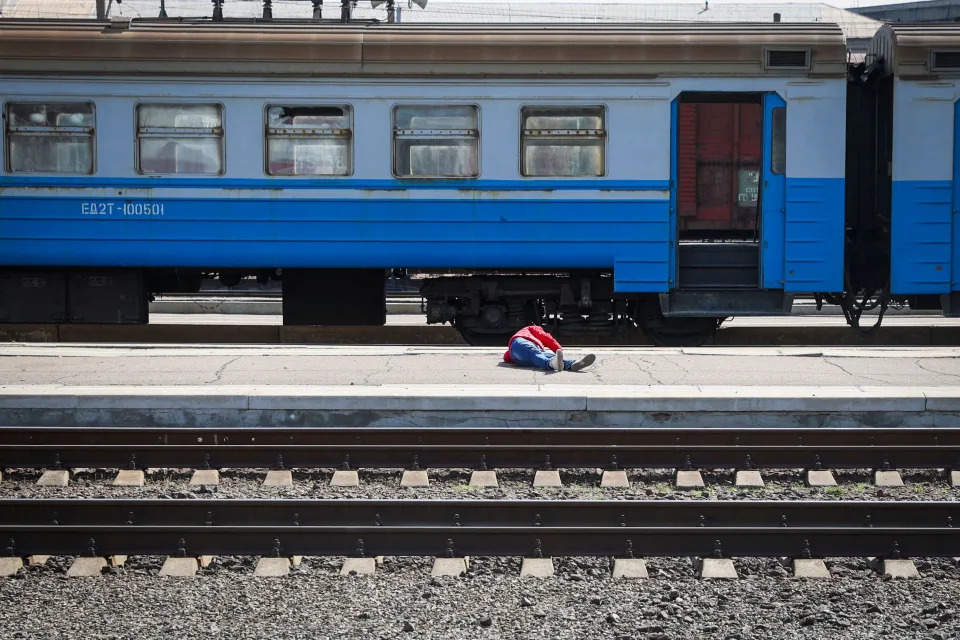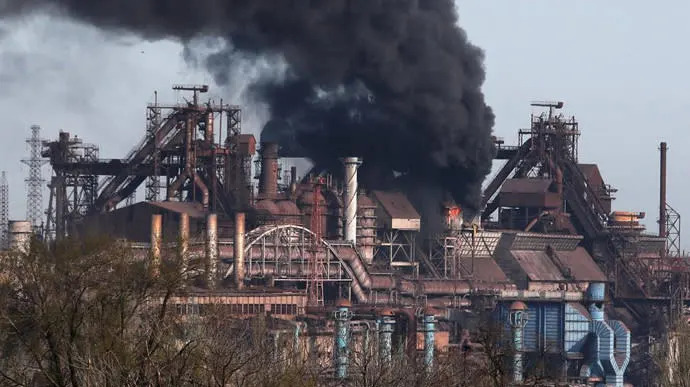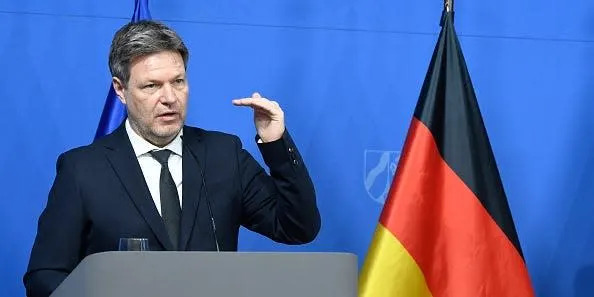Reuters
Pelosi pledges U.S. support on visit to Ukraine; civilians evacuated from Mariupol
April 30, 2022
KYIV/BEZIMENNE, Ukraine (Reuters) -Around 100 Ukrainian civilians were evacuated from the ruined Azovstal steelworks in the city of Mariupol on Sunday, Ukrainian President Volodymyr Zelenskiy said, after the United Nations confirmed a “safe passage operation” was in progress there.
The strategic port city on the Azov Sea has endured the most destructive siege of the war with Russia – now in its third month – with Pope Francis, in an implicit criticism of Moscow, telling thousands of people in St Peter’s Square on Sunday it had been “barbarously bombarded”.
“For the first time, we had two days of a ceasefire on this territory, and we managed to take out more than 100 civilians – women, children,” Zelenskiy said in a nightly video address.
The first evacuees would arrive in the Ukrainian-controlled city of Zaporizhzhia on Monday morning, he said, adding that he hoped conditions would continue that allowed for more people to be evacuated.
With fighting stretching along a broad front in southern and eastern Ukraine, U.S. House of Representatives Speaker Nancy Pelosi pledged continued U.S. support for Ukraine “until victory is won” after she met Zelenskiy in an unannounced visit to Kyiv.
Russia’s military has turned its focus to Ukraine’s south and east after failing to capture Kyiv in the early weeks of a war that has flattened cities, killed thousands of civilians and forced more than 5 million to flee the country.
In Mariupol, Moscow declared victory on April 21 even as hundreds of holdout Ukrainian troops and civilians took shelter in the Azovstal steelworks, a vast Soviet-era complex with a network of bunkers and tunnels, where they have been trapped with little food, water or medicine.
Negotiations to evacuate the civilians had repeatedly broken down in recent weeks, with Russia and Ukraine blaming each other.
But on Sunday, more than 50 civilians arrived at a temporary accommodation centre after escaping from Mariupol, a Reuters photographer said.
The civilians arrived on buses in a convoy with U.N. and Russian military vehicles at the Russian-held village of Bezimenne, around 30 km (18 miles) east of Mariupol, where a row of light blue tents had been set up.
One of the evacuees, Natalia Usmanova, 37, said she had been so terrified as Russian bombs rained down on the plant sprinkling her with concrete dust that she felt her heart would stop.
“When the bunker started to shake, I was hysterical. My husband can vouch for that. I was so worried the bunker would cave in,” she told Reuters in Bezimenne.
A spokesperson for the U.N. Office for the Coordination of Humanitarian Affairs said a “safe passage operation” had started on Saturday and was being coordinated with the International Committee of the Red Cross, Russia and Ukraine.
He said no further details could be released so as not to jeopardise the safety of evacuees and the convoy.
Denys Shleha, commander of Ukraine’s 12th National guard brigade, speaking to television on Sunday from the Azovstal plant, said several hundred civilians remained in bunkers there, including about 20 children, and that one or two additional evacuation efforts of similar scale would be needed.
Russia’s defence ministry said 80 civilians had been evacuated from the plant.
A plan to evacuate civilians from areas of the devastated city outside the steelworks had been postponed to Monday morning, Mariupol’s city council said.
U.S. ‘STANDS WITH UKRAINE’
Footage posted by Zelenskiy on Twitter on Sunday showed him, flanked by an armed escort and dressed in military fatigues, greeting a U.S. congressional delegation led by Pelosi outside his presidential office the previous day.
“We stand with Ukraine until victory is won. And we stand with our NATO allies in supporting Ukraine,” Pelosi, the highest ranking U.S. official to visit Ukraine since Russia invaded on Feb. 24, said on Sunday at a press briefing in Poland.
Zelenskiy praised as substantive four hours of talks with Pelosi focused on U.S. weapons deliveries, adding he was grateful to all of Ukraine’s partners who visit Kyiv at such a difficult time.
U.S. Senate Democratic leader Chuck Schumer said in New York he would add provisions to a $33 billion Ukraine aid package to allow the United States to seize Russian oligarchs’ assets and send money from their sale directly to Kyiv.
President Joe Biden asked Congress to approve the aid package on Thursday in what would mark a dramatic escalation of U.S. funding for Ukraine.
Biden spoke with Pelosi on Sunday about her trip, a White House official said without elaborating.
Moscow calls its actions a “special military operation” to disarm Ukraine and rid it of anti-Russian nationalism fomented by the West. Ukraine and the West say Russia launched an unprovoked war of aggression.
Russia’s Foreign Minister Sergei Lavrov said Moscow was not demanding that Zelenskiy “give himself up” as a condition for peace.
“We are demanding that he issue an order to release civilians and stop resistance. Our aim does not include regime change in Ukraine,” Lavrov said in a media interview published on his ministry’s website.
EASTERN PUSH
In the east, Moscow is pushing for complete control of the Donbas region, where Russian-backed separatists already controlled parts of Luhansk and Donetsk provinces before the invasion.
On Sunday, Kharkiv region governor Oleh Synehubov warned residents in the north and east of the city of Kharkiv to remain in their shelters due to heavy Russian shelling. Reuters could not immediately verify reports of shelling in the area.
Serhiy Gaidai, governor of the Luhansk region, in a social media post, urged people to evacuate while it was still possible.
Ukraine’s military said Russian forces were fighting to push north from Kherson to the cities of Mykolayiv and Kryvyi Rih, and Zelenskiy said Russian troops continued to launch strikes on residential areas and had destroyed grain storage depots.
“This will only build up the toxic attitude to the Russian state and increase the numbers of those working to isolate Russia,” Zelenskiy said.
(Reporting by Hamuda Hassan and Jorge Silva in Dobropillia, Ukraine, and Natalia Zinets in Kyiv; Additional reporting by Reuters journalists; Writing by Clarence Fernandez, Frances Kerry, Alex Richardson and Michael Martina; Editing by David Goodman, Alexandra Hudson, Angus MacSwan, Daniel Wallis and Diane Craft)








